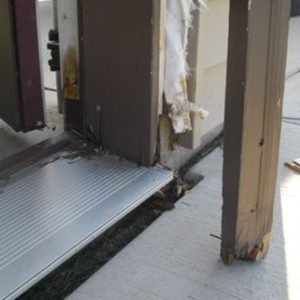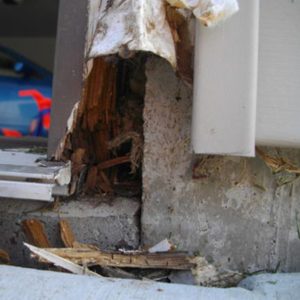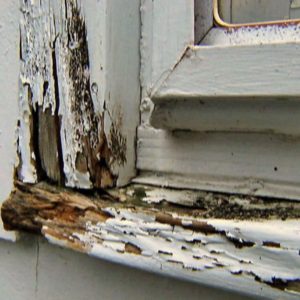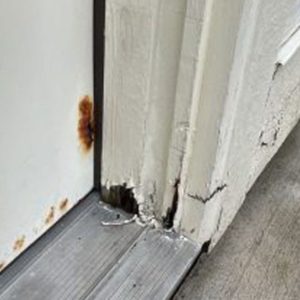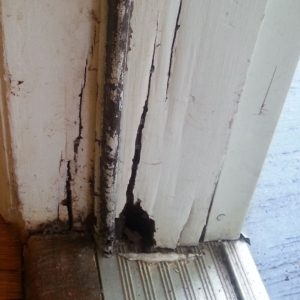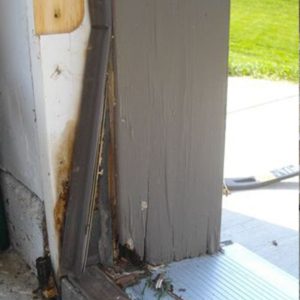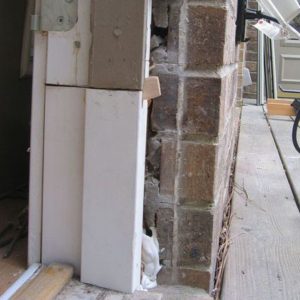The Columbus Home Heroes wood rot repair specialists know how to diagnose what type of wood rot is affecting your home. It’s important to know what kind of rot is infecting your wood so that we can find the source of the issue and how extreme the fungus and/or mold levels are. The three types are brown rot, white rot, and soft rot, all being caused by moisture, there is no such thing as dry rot.
Reliable Professional Advice on How to Take Care of Wood Rot in Columbus, OH and Nearby Cities
Wood rot can do lots of damage to a home if left unchecked. Save yourself the expenses that come with damage and see how you can prevent it in your home.
Where Can Wood Rot Happen?
High-risk areas around the home can be anywhere that is susceptible to letting in or building up moisture. This moisture can and will damage the wood. This can be your roof, wet rooms, basement, bathrooms, exterior doors, and windows. Check these spots every year in your home to make sure no damages are occurring. It’s ideal to do this before winter with a flashlight and a long-handled screwdriver. If any of the wood is wet or can be punctured by the screwdriver, that is a bad sign for rot.
Rot can be seen as discolored wood, soft wood, an odor, and visible swelling. While looking for signs of rot, be sure to check crawl space, siding, any perimeter woods, spaces around the sinks, tubs, showers, and more.
What Causes Rot Anyway?
The fungal spores that cause wood to rot are all around us. Fortunately, they are not always active, and rot damage does not occur overnight. Dry rot is a common type of wood rot in which wood is attacked by fungi. The fungi destroy the parts of the wood that make it strong and firm.
To grow and begin to digest wood, fungal spores need adequate amounts of water and high relative humidity. When the moisture content of the materials with which your home is built is coupled with high relative humidity, the stage is set for rot. For roofs, this often occurs when a small leak goes unnoticed and allows water to soak into the frame.
Where to inspect for wood rot
- Exterior windowsills and door thresholds
- Exterior window and door casings (trim)
- The underside of roof decking (if accessible from the attic)
- Roof framing (if accessible from the attic)
- Fascia (trim to which gutters are often attached) and rake boards (trim on the gable end of a roof)
We address rot at the source
There are several different factors that can cause wood rot in your roof, which is why it’s important to understand what problems can make your home at risk.
- Clogged or misaligned gutters:If your gutters are clogged or misaligned, tremendous amounts of water can enter your home and saturate the ground around your foundation (which can also allow water to seep into your home). Properly cleaning and maintaining gutters ensures rainwater drains away from your home.
- Roof ventilation:The roof is more than a barrier to rain and snow — it’s also where your home exhales! A properly vented roof also expels much of the water vapor that builds up in the home and plays an important role in keeping the moisture content in building materials to safe levels. Vent openings are typically located along the roof’s ridge and soffits at the eaves and are usually continuous in order to maintain adequate air flow.
- Damaged roofing materials:Water is necessary for wood rot, and there’s no surer way for water to get into your roof than cracked, missing, or torn shingles. By ensuring that you maintain your roof and apply the right roof repairs when necessary, you can limit the risk of a roof leak that leads to wood rot.
Door Rot Repair
Do you have a door that has been subjected to the harsh elements of Ohio? We repair patio doors, french doors, sliding doors, double doors, and entry doors. Columbus Home Heroes’ specialty is to remove the rotted part of the jamb and replace it with new.
Not just epoxy or filler to cover or hide rot. We do it the right way by installing new wood, metal, or plastic – whatever the original manufacturer used in the first place. We can remove the problem areas and replace them, back to original, while at the same time saving you up to 75%. Including the necessary painting or staining inside and out.
Clad Window Rot Repair, Columbus
Are you noticing a draft coming in through your windows? Are you seeing rot on the interior or exterior of your windows? If so, it’s time for window rot repair from Columbus Home Heroes. We are a full-service exteriors contractor serving Indianapolis and Central Indiana, and we can repair your windows quickly and efficiently.
Window rot can be caused by several factors, including water damage, humidity, and extreme weather conditions. If left untreated, window rot can lead to more serious problems, such as water damage to your home’s interior.
That’s why it’s important to have your windows repaired as soon as possible. At Energy Smart Exterior Restoration, we offer a variety of window rot repair services, including:
- Window caulking
- Window replacement
- Window weatherstripping
- Window wood rot repair
No matter what type of window rot you have, we can fix it. We are a 5-star rated and fully insured company, and we offer a robust guarantee on all of our services.
We fix rotten window frames and trim window sash repair and replacement. Did you know, repair vs replacement gives you up to 75% savings. Why replace when we can repair and make the windows as good as new.
Contact Columbus Home Heroes and we will send someone out to review your issues and get started repairing or replacing your rotted window frame or sash to that like new look. Also we can replace current wood sashes and sills and trim with composite trim.
Type of Wood Rot
Brown Rot: This type of decay is caused by fungi that attack the cellulose in wood fiber, giving the damaged wood a brown tint. This is the most common form of wood deterioration caused by fungi and includes “dry rot”. Dry rot is somewhat inappropriate as it requires some moisture to be present.
The fungus can transport water through cords in affected wood, allowing it to attack apparently dry wood.
White Rot: The fungus that causes this type of rot attacks both the cellulose and lignin in the wood fiber, leaving the affected wood with a bleached appearance. White rot is most common in hardwoods, which are commonly used for floors or furniture. Soft woods are commonly used in structural applications, and these are more prone to dry rot.
In general, the white rot fungus mainly reduces the compressive strength of the wood, whereas brown rot and soft rot decrease its buckling capacity. A significant loss of this resistance already occurs even before rot is detected in the wood.
Signs that tell if the wood is rotten:
- Weak points : Check the wood for weak points. If you encounter weak spots, press the blunt side of an awl or screwdriver into the spot. If the wood bounces back immediately, in most cases it is rotten wood.
- Loosening of the paint : If the paint is loosening , it may be due to rotten wood. You should therefore carefully check the paint layer for cracks, air bubbles or flaking.
- Discoloration of the wood : If the wood turns brown or black, this usually indicates rotten wood. If the color is light gray, the wood is still good, but moisture has already entered. Unfortunately, discoloration can only be seen on unpainted wood.
- Rotten wood is also easily crumbled and some woods are warped or even bulging due to water saturation. The surface of the wood is covered in cracks and a carpet of moss or fungus begins to spread.
Wood Rot Inspection in Columbus, OH
An annual inspection of your interior and exterior wood fixtures & trim is always a great way to identify any early signs of rot. Here are the signs you should elicit whether your wood decors are facing dry rot or not.
- Darkened timber – darker than surrounding timber
- Soft and spongy timber
- Cracked appearance that may crumble to touch when dry
- Localized fungus growth
- Shrinkage
- A damp, musty smell
Columbus Home Heroes follows three basic steps to rescue your wood items. Here we go,
- Inspection
Firstly, we deeply investigate the sources of wood rot, such as leaks and poor weather shields around the wood articles. Once we identify the actual cause of rot decay, we move toward the further process. - Removing and Repairing the Softwood
Our professional staff carefully peeled off the damaged wood and sanded it for its smooth alignment with the original structure. - Seal, Prime, Paint
In the last step, we seal the repaired surface to prevent the rot come back again. Afterwards, we prime and repaint it to hide all the repair marks to get a fabulous and fresh look.

